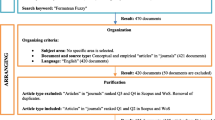Abstract
A control chart is a tool for investigating whether the variation in a production process is random or assignable. X − M R control chart is a binary control chart on which average values of process and moving range between observations are used to discover the variability in the process. In an ordinary control chart, the data are crisp values but sometimes, the data are generated as vague and uncertain values because of some of environmental conditions and other factors. In such cases, fuzzy sets theory is a useful tool for analyzing data. On the other hand, the assumption of independence between observations cannot be accepted because the probability of false warning will increase if the data are autocorrelated and their correlation is ignored. In this article, we will discuss the construction of fuzzy control charts for autocorrelated fuzzy observations and employment of ranking method in order to find out whether the observations are in or out of control. In fact, by using defined D p,q -distance between fuzzy numbers, we calculate their variance, covariance, and autocorrelation coefficient. The autocorrelation coefficient is used in order to modify the limit of control chart. By using D p,q -distance, we present a new approach for constructing control charts.
Similar content being viewed by others
References
Alwan LC, Roberts HV (1988) Time series modeling for statistical process control. Journal Of Business & Economic Statistics 6:87–95
Box GEP, Luceno A (1997) Statistical control by monitoring and feedback adjustment. Wiley, New York
Bustince H, Burillo P (1995) Correlation of interval-valued intuitionistic fuzzy sets. Fuzzy Sets Syst 74:237–244
Carlsson C, Fullér R, Majlender P (2005) On possibilistic correlation. Fuzzy Sets Syst 155:425–445
Cheng CB (2005) Fuzzy process control: Construction of control charts with fuzzy numbers. Fuzzy Sets Syst 154:287–303
Erginel N (2008) Fuzzy individual and moving average control charts with a-cut. J Intell Fuzzy Syst 19:373–383
Faraz A, Moghadam M (2007) Fuzzy control chart a beter alternative for shewhart average chart. Qual Quant 41:375–385
Goldsmith PH, Whitfield H (1961) Average run lengths in the cumulative chart quality control schemes. Technimetrics 3:11–20
Grzegorzewski P (1997) Control charts for fuzzy data. In: Proceedings of the 5th European congress on intelligent techniques and soft computing EUFIT97, 1326-1330. Aachen
Grzegorzewski P (1998) Metrics and orders in space of fuzzy numbers. Fuzzy Set Syst 97:83–94
Gülbay M, Kahraman C (2006) Development of fuzzy process control charts and fuzzy unnatural pattern analyses. Comput Stat Data Anal 51:434–451
Gülbay M, Kahraman C, Ruan D (2004) a-Cuts fuzzy control charts for linguistic data: International. J Intell Syst 19:1173–1196
Hung W, Wu J (2002) Correlation of intuitionistic fuzzy sets by centroid method. Inf Sci 144:219–225
Kanagawa A, Tamaki F, Ohta H (1993) Control charts for process average and variability based on linguistic data. Int J Prod Res 31(4):913–922
Kaya I, Kahraman C (2011) Process capability analyses based on fuzzy measurements and fuzzy control charts. Expert Syst Appl 38:3172–3184
Laviolette M, Seamanb JW, Barrett JD, Woodall WH (1995) A probabilistic and statistical view of fuzzy methods. Technometrics 37(3):249–261
Lu CW, Reynolds MR JR (1999) EWMA control charts for monitoring the mean of autocorrelated process. J Qual Technol 31:166–188
Lu CW, Reynolds MR JR (2001) CUSUM charts for monitoring an autocorrelated process. J Qual Technol 33:316–334
Mahdavi I, Heidarzadeh A, Sadeghpour Gildeh B, Mahdavi Amiri N (2009) A general fuzzy TOPSIS model in multiple criteria decision making. Int J Adv Manuf Technol 45:406– 429
Maragah H, Woodall WH (1992) The effect of autocorrelation on the restropective X chart. Commun Stat Simul Comput 40(1):29–42
Mohammadi J, Taheri SM (2003) Pedomodels fitting with fuzzy least squares regression. Iranian J Fuzzy Syst 1:45–62
Montgomary DC (2009) Introduction to statistical quality control, 6th ed. Wiley, New York
Noorossana R, Farrokhi M, Saghaei A (2003) Using neural networks to detect and classify out-of-control signals in autocorrelated processes. Qual Reliab Eng Int 19(6):493–504
Prajapati DR (2003) Performance of Conventional X-bar Chart for Autocorrelated Data Using Smaller Sample Sizes. In: Proceedings of the World Congress on Engineering and Computer Science 2013 Vol II, October 23-25, 2013, San Francisco, USA
Puri ML, Ralescu DA (1986) Fuzzy random variables. J Math Anal Appl 114:409–422
Raz T, Wang JH (1990) Probabilistic and membership approaches in the construction of control charts for linguistic data. Prod Plan Control 1:147–157
Reynolds MR JR, Arnold JC, Baik JW (1996) Variable sampling interval X charts in the presence of correlation. J Qual Technol 28:12–30
Sadeghpour Gildeh B, Gien D (2001) La distance-Dp,q et le coefficient de corrélation entre deux variables aléatoires floues. Rencontres francophones sur la logique floue et ses applications LFA 01, November 26-27, 2001, 97-102. Mons, Belgium
Tajdin A, Mahdavia I, Mahdavi-Amiri N, Sadeghpour Gildeh B (2010) Computing a fuzzy shortest path in a network with mixed fuzzy arc lengths using lengths using a-Cut. Comput Math Appl 60:989–1002
Wang JH, Raz T (1990) On the construction of control charts using linguistic variables. Int J Prod Res 28:477–487
Woodall WH, Faltin FW (1993) Autocorrelated data and SPC. ASQC Statistics Division. Newsletter 13(4):18–21
Zadeh LA (1965) Fuzzy set. Inf Control 8:338–353
Author information
Authors and Affiliations
Corresponding author
Rights and permissions
About this article
Cite this article
Gildeh, B.S., Shafiee, N. X-MR control chart for autocorrelated fuzzy data using D p,q -distance. Int J Adv Manuf Technol 81, 1047–1054 (2015). https://doi.org/10.1007/s00170-015-7199-7
Received:
Accepted:
Published:
Issue Date:
DOI: https://doi.org/10.1007/s00170-015-7199-7




